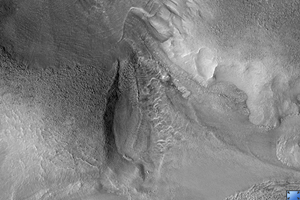
Click on image for larger versionThis HiRISE image (PSP_002098_2220) shows part of the central uplift of Moreux Crater, at about 42 degrees north of the equator.
In several parts of the image, the underlying topography appears mantled by a later deposit. This appears mostly in topographic lows and has lineations which suggest that it has flowed downslope, suggesting that this mantle may have been ice-rich.
In one point near the center of the image, some of this material appears detached in a local topographic minimum; however, this patch is still lineated. North of the image center there are several patches of dark material which appear smooth at low resolution (zoomed out). A closer look reveals that these areas are broken into polygonal patterns, which may be due to stresses created by temperature variations. Such polygons often indicate the presence of ground ice near the surface.
Sites like this provide a wealth of information about processes affecting the surface of Mars.
Observation Toolbox
Acquisition date: 1 January 2007
Local Mars time: 3:29 PM
Degrees latitude (centered): 41.7°
Degrees longitude (East): 44.4°
Range to target site: 297.7 km (186.0 miles)
Original image scale range: from 29.8 cm/pixel (with 1 x 1 binning) to 59.6 cm/pixel (with 2 x 2 binning)
Map-projected scale: 25 cm/pixel and north is up
Map-projection: EQUIRECTANGULAR
Emission angle: 0.8°
Phase angle: 57.0°
Solar incidence angle: 58°, with the Sun about 32° above the horizon
Solar longitude: 162.5 °, Northern Summer
NASA's Jet Propulsion Laboratory, a division of the California Institute of Technology in Pasadena, manages the Mars Reconnaissance Orbiter for NASA's Science Mission Directorate, Washington. Lockheed Martin Space Systems, Denver, is the prime contractor for the project and built the spacecraft. The High Resolution Imaging Science Experiment is operated by the University of Arizona, Tucson, and the instrument was built by Ball Aerospace and Technology Corp., Boulder, Colo.

